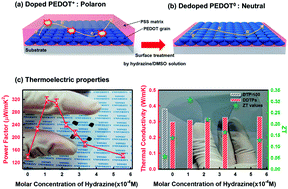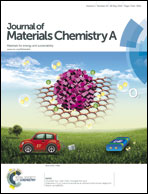Transparent and flexible organic semiconductor nanofilms with enhanced thermoelectric efficiency†
Abstract
Sequential doping and dedoping increased the conductivity and optimized the oxidation level of transparent and flexible poly(3,4-ethylenedioxythiophene):poly(4-styrene sulfonic acid) (PEDOT:PSS) films, resulting in an improvement in the thermoelectric figure of merit ZT. The electrical conductivity (σ) increased from 970 to 1260 S cm−1 and the power factor from 66.5 to 70.7 μW mK−2 at the optimum concentration of the chemical dopant p-toluenesulfonic acid monohydrate (TSA). Then, the doped PEDOT:PSS films were treated with hydrazine/DMSO solutions with different hydrazine concentrations to precisely control the oxidation level. During the hydrazine/DMSO treatment (dedoping), σ of the films continuously decreased from 1647 to 783 S cm−1 due to a decrease in the carrier concentration, whereas the Seebeck coefficient (S) steeply increased from 28 to 49.3 μV K−1 at the optimum oxidation level. A power factor of 318.4 μW mK−2 (σ = 1310 S cm−1, S = 49.3 μV K−1), the highest among all existing thermoelectric nanofilms, was achieved while maintaining polymer film flexibility and transparency (88.3% of optical transmittance). In addition, the thermal conductivity (κ) of the PEDOT:PSS films decreased from 0.38 to 0.30 W mK−1 upon removal of PSS. At the lowest κ value, a high ZT value of 0.31 was achieved at room temperature.


 Please wait while we load your content...
Please wait while we load your content...